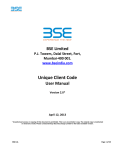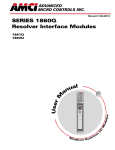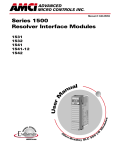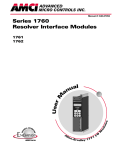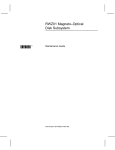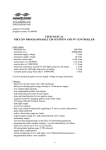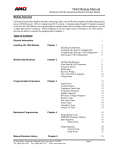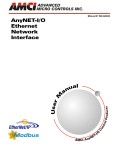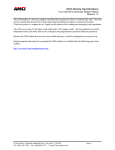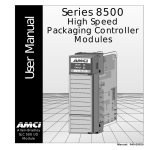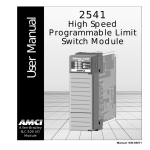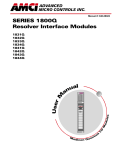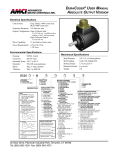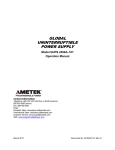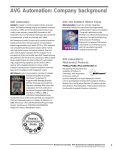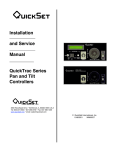Download 1561 manual - Advanced Micro Controls Inc
Transcript
ADVANCED MICRO CONTROL S INC. Manual #: 940-05041 od ule s al u an M User M 1561 Multi-Turn Resolver Interface Modules A ll e n- Bra 50 C dle y S L 0 I/ O GENERAL INFORMATION Important User Information The products and application data described in this manual are useful in a wide variety of different applications. Therefore, the user and others responsible for applying these products described herein are responsible for determining the acceptability for each application. While efforts have been made to provide accurate information within this manual, AMCI assumes no responsibility for the application or the completeness of the information contained herein. UNDER NO CIRCUMSTANCES WILL ADVANCED MICRO CONTROLS, INC. BE RESPONSIBLE OR LIABLE FOR ANY DAMAGES OR LOSSES, INCLUDING INDIRECT OR CONSEQUENTIAL DAMAGES OR LOSSES, ARISING FROM THE USE OF ANY INFORMATION CONTAINED WITHIN THIS MANUAL, OR THE USE OF ANY PRODUCTS OR SERVICES REFERENCED HEREIN. Throughout this manual the following two notices are used to highlight important points. WARNINGS tell you when people may be hurt or equipment may be damaged if the procedure is not followed properly. CAUTIONS tell you when equipment may be damaged if the procedure is not followed properly. No patent liability is assumed by AMCI, with respect to use of information, circuits, equipment, or software described in this manual. The information contained within this manual is subject to change without notice. Standard Warranty ADVANCED MICRO CONTROLS, INC. warrants that all equipment manufactured by it will be free from defects, under normal use, in materials and workmanship for a period of [1] year. Within this warranty period, AMCI shall, at its option, repair or replace, free of charge, any equipment covered by this warranty which is returned, shipping charges prepaid, within one year from date of invoice, and which upon examination proves to be defective in material or workmanship and not caused by accident, misuse, neglect, alteration, improper installation or improper testing. The provisions of the “STANDARD WARRANTY” are the sole obligations of AMCI and excludes all other warranties expressed or implied. In no event shall AMCI be liable for incidental or consequential damages or for delay in performance of this warranty. Returns Policy All equipment being returned to AMCI for repair or replacement, regardless of warranty status, must have a Return Merchandise Authorization number issued by AMCI. Call (860) 585-1254 with the model number and serial number (if applicable) along with a description of the problem. A “RMA” number will be issued. Equipment must be shipped to AMCI with transportation charges prepaid. Title and risk of loss or damage remains with the customer until shipment is received by AMCI. 24 Hour Technical Support Number 24 Hour technical support is available on this product. For technical support, call (860) 583-7271. Your call will be answered by the factory during regular business hours, Monday through Friday, 8AM - 5PM EST. During non-business hours an automated system will ask you to enter the telephone number you can be reached at. Please remember to include your area code. The system will page one of two engineers on call. Please have your product model number and a description of the problem ready before you call. ADVANCED MICRO CONTROLS INC. TABLE OF CONTENTS General Information Chapter 2: Installation (continued) Important User Information ............. Inside Cover Standard Warranty ........................... Inside Cover Returns Policy .................................. Inside Cover 24 Hour Technical Support Number Inside Cover About This Manual Introduction .............................................. 3 Revision Record ....................................... 3 Revision History ............................ 3 Specifications Specifications ........................................... 4 Chapter 1: Introduction Overview .................................................. 5 New Features ........................................... 5 Backwards Compatibility ........................ 6 “-19 option” ................................... 6 Series 1500 Family Members .................. AMCI Compatible Transducers ............... Other Compatible Transducers ................ Programmable Parameters ....................... Transducer Type ............................ 8 Number of Turns ........................... 9 Full Scale Count ............................ 9 Count Direction ............................. 10 Transducer Fault Latch .................. 10 Preset Value ................................... 10 6 7 8 8 Backplane Programming .......................... 10 Programming Cycle ....................... 10 Chapter 2: Installation Power Requirements ................................ Installing the Module ............................... Module ID Code ...................................... Status LED’s ............................................ 11 11 11 12 Transducer Input Connector ..................... 12 Transducer Cable Installation .................. 13 Transducer Cable Wiring Diagram .......... 13 CTT-(x) Wiring Diagram (1561) . 13 Transducer Specifications ........................ 14 Transducer Mounting ............................... 14 Transducer Outline Drawings .................. 14 HTT-20-(x) Outline Drawing ....... 15 Transducer Connector Pinout ....... 15 Autotech Transducer Installation ............. 15 Supported Transducers ................. 15 Autotech Transducer Wiring ........ 16 Chapter 3: Backplane Programming Data Addressing ....................................... 17 Programming Cycle ................................. 17 Guidelines for Programming an Older Module 17 Multi-Word Format .................................. 18 Output Image Table .................................. 18 Apply Preset Bit: O:X.0/00 ........... 18 Programming Bits: O:X.0/01 to O:X.0/05 ................. 19 Command Bits: O:X.0/13 and O:X.0/14 .............. 19 Transmit Bit: O:X.0/15 ................. 20 Ranges and Factory Default Values ............................ 20 Input Image Table .................................... 20 Position and Tachometer Data ...... 20 Programming Error Bits: I:X.0/00 to I:X.0/08 21 Status Bits: I:X.0/11 to I:X.0/14 ... 21 Acknowledge Bit: I:X.0/15 ........... 21 Programming Example ............................. 22 Ladder Logic ................................. 23 20 Gear Drive, Plymouth Ind. Park, Terryville, CT 06786 Tel: (860) 585-1254 Fax: (860) 584-1973 http:\\www.amci.com 1 TABLE OF CONTENTS NOTES 2 ADVANCED MICRO CONTROLS INC. ABOUT THIS MANUAL It is strongly recommended that you read the following manual. It was first written for the release of hardware series E, firmware version 6, which introduced many new features into the 1561 module. Backwards compatible “out-of-the-box” with older versions of this module, the new features are easily enabled over the backplane. If there are any unanswered questions after reading this manual, call the factory. An applications engineer will be available to assist you. For additional information on our SLC modules as well as the rest of AMCI’s products, check out our website at www.amci.com. Firmware rev E, software rev 6+ was released with serial number 59,730. If your 1561 has a serial number below 59,730, you can still use this manual as long as your are aware of three items. 1) All new features introduced with hardware series E are not available on your module. See New Features on page 5 for a list of these features. 2) Older modules do not directly support Autotech RL210 transducers unless they have the “-19” option. 3) You must not set any of the programming bits associated with the new features when you program your module. See Guidelines for Programming an Older Module on page 17 for complete information on programming your module. Introduction This manual explains the operation, installation, and programming of 1561 Resolver Interface Module for the Allen-Bradley SLC 500™ programmable controller systems. Utilizing licensed Allen-Bradley SLC 500 I/O interface technology, this one slot Resolver Interface Module accepts a single multi-turn transducer input and plugs directly into the A-B SLC 500 rack. Communicating through I/O registers assigned to the slot, this module supplies absolute position and tachometer data to any SLC processor from the AMCI resolver based transducer. Status information is also transferred to the SLC processor. The AMCI logo is a trademark and “AMCI” is a registered trademark of Advanced Micro Controls Inc. “SLC” and “SLC 500” are trademarks of Allen-Bradley Company. This product incorporates technology which is licensed by Allen-Bradley Company, Inc. Allen-Bradley has not technically approved, nor does it support this product. All warranty and support for this product and its application is provided solely by Advanced Micro Controls Inc. Manuals at AMCI are constantly evolving entities. Your questions and comments on this manual and the information it contains are both welcomed and necessary if this manual is to be improved. Please direct all comments to: Technical Documentation, AMCI, 20 Gear Drive, Terryville CT 06786, or fax us at (860) 5841973. You can also e-mail your questions and comments to [email protected] Revision Record This manual, 940-05041, supersedes 940-05040 and was first released 7/6/2000. Its release corresponds with the release of hardware series E, firmware version 6. This hardware/firmware change added many features that are documented in this manual revision. Revision History 940-05040: 7/21/98. Added parameter range table and updated illustration artwork. 1560-594M: Original cataloged manual 20 Gear Drive, Plymouth Ind. Park, Terryville, CT 06786 Tel: (860) 585-1254 Fax: (860) 584-1973 http:\\www.amci.com 3 SPECIFICATIONS Module Location Any SLC 500 I/O slot, including the processor slot of an extended rack. Occupies one slot. Position Transducer Default of AMCI multi-turn brushless resolver transducer Can be programmed to use Autotech RL210 128 turn transducers. Transducer Input Isolation 1500 Vac through isolation transformers Data Available to Processor Transducer Position, Velocity and Fault Diagnostic data Programmable Parameters Transducer Type Number of Turns Full Scale Count Preset Value Count Direction Transducer Fault Latch Program Storage EEPROM Memory Minimum 100,000 write cycles Position Update Time 400 microseconds 4 Position Resolution AMCI 100, 180 turn Transducers: Programmable to 4,096 counts per turn AMCI 1,000, 1,800 turn Transducers Programmable to 409.6 counts per turn Autotech Transducers: Programmable to 1,024 counts per turn Tachometer Resolution and Range 1 RPM over 0 to 3,750 RPM range. Updated every 32 milliseconds DC Supply Voltage from Backplane 0.090A max. @ 5Vdc nominal 0.055A max. @ 24Vdc nominal 0.160A max. @ 24Vdc under short circuit conditions Environmental Conditions Operating Temperature: 0 to 60° C Relative Humidity: 5 to 95% (w/o condensation) Storage Temperature: -40 to 85° Module ID Code 3514 Reserves 8 Input and 8 Output Registers Number of registers scanned can be set using SPIOGA Configuration. Registers Used 4 Input, 7 Output ADVANCED MICRO CONTROLS INC. CHAPTER 1 INTRODUCTION Overview The Series 1561 module is an Allen-Bradley SLC 500 I/O compliant card that converts resolver signals from an absolute, dual resolver, multi-turn transducer to digital position and tachometer data that is reported over the backplane. Status information is also reported. The 1561 eliminates the separate resolver decoder box, PLC input card, and associated wiring needed to bring resolver data into a SLC. Like an absolute optical encoder, a resolver is a sensor that converts an angle into electrical signals. However, this is where the similarities end. The resolver is an analog device that does not contain sensitive components such as optics and electronics that may be damaged by severe environmental conditions. Also, the position resolution of a resolver is limited only by the electronics that decode its signals. When attached to a 1561 module, the resolver gives an absolute position value with up to twenty bits of position resolution over one hundred eighty turns using a twelve conductor cable. An absolute optical encoder would require a cable with at least twenty-two wires to accomplish the same resolution. A 1561 application generally falls into one of two categories. h Rotary Application - The resolver position directly correlates to an angular position on the machine. One example is monitoring a rotary table by attaching a multi-turn transducer to the drive motor and using it to monitor and control such functions as motor braking to stop the table at its stations. h Linear Application - The resolver position correlates to a physical Figure 1.1 1561 Module length. One example is monitoring the position of a load on either a track or ball screw such as a press shut height monitor. In this type of application, linear position is translated to rotary position through either a wheel or gearing. The transducer completes several rotations in order to travel the entire distance. New Features The hardware series E, firmware revision 6 release of the 1561 modules adds several new features to the product. These features are: h Preset Value: Allows you to preset the position value to any count within its range. Previous versions of the module only allowed you to reset the position to zero. h Count Direction: Allows you to set the direction of rotation that produces increasing counts. With pre- vious versions of the module, you had to change the transducer cable wiring to reverse count direction. h Transducer Fault Latch: Allows you to decide if a transducer fault should clear itself when possible, or latch the fault and stay in the fault condition until it is cleared from the backplane. Previous versions of the modules always self-cleared the fault. h Autotech RL210 Compatibility: You can program the Transducer Type parameter to a value of 128. When you do this, the module automatically adjusts the reference voltage to the transducer to make the module directly compatible with the Autotech RL210 128 turn transducers. 20 Gear Drive, Plymouth Ind. Park, Terryville, CT 06786 Tel: (860) 585-1254 Fax: (860) 584-1973 http:\\www.amci.com 5 1 INTRODUCTION Backwards Compatibility With these new features, you may have some concerns if you are using a new 1561 module to replace an older one, or building a new machine based on a design that used an older module. Rest assured that AMCI took backward compatibility issues into account when designing this upgrade. Modules built on series E, firmware 6 and later, are backwards compatible with older modules “out-of-thebox”. When shipped from the factory, all of the parameters are set to their default values, which makes the newer 1561’s behave exactly as the older ones. All backplane programming of the new features use bits and words that were previously reserved. If you followed AMCI’s suggestion and made all of these reserved bits zero in your old ladder logic and data, your program will work without error. The only reason to change your program and data is to program the new features. “-19 option” An option was available on certain older 1561 modules that made them compatible with transducers from Autotech Controls. This option was denoted by adding “-19” to the end of the part number. With the release of series E, version 6, all 1561 modules can be programmed to directly support AMCI or Autotech transducers. Consequently, the “-19” option is being phased out. If you are replacing a module with a “-19” option, you can now order a standard product and have the same functionality. Series 1500 Family Members Table 1.1 below shows the six members of the Series 1500 family of modules. Only the 1561 is covered by this manual. The comments in the table gives the name of the appropriate manual for our other Series 1500 modules. These manuals are available at our website, www.amci.com,.for free download in PDF format. Model Transducer Comments Inputs 1531 1 1532 2 1541 1 1542 2 1541-12 1 1541-03 1 1561 1 Single turn, 10 bit (1,024 count) position resolution. See Series 1500 Resolver Interface Modules User Manual. Single turn, 10 bit (1,024 count) position resolution. See Series 1500 Resolver Interface Modules User Manual. Single turn, 13 bit (8,192 count) position resolution. See Series 1500 Resolver Interface Modules User Manual. Single turn, 13 bit (8,192 count) position resolution. See Series 1500 Resolver Interface Modules User Manual. Single turn, 13 bit (8,192 count) position resolution 0.1 RPM resolution tachometer. See Series 1500 Resolver Interface Modules User Manual. 12 bit (4,096 count) brake monitor module with remote display. See 1541-03 Resolver Input Brake Monitor Module User Manual. Absolute multi-turn module. 12 bit (4,096 count) per turn, 180 turns max. (737,280 maximum counts). With proper transducer, can be used for applications of up to 1,800 turns at 409.6 counts per turn. Table 1.1 Series 1500 Modules 6 ADVANCED MICRO CONTROLS INC. 1 INTRODUCTION AMCI Compatible Transducers Table 1.2 lists the AMCI transducers compatible with the 1561 module. Model Shaft Mount Turns HTT-20-100 HTT-20-180 0.625" 0.625" Front Front 100 180 HTT-20-1000 0.625" Front 1,000 HTT-20-1800 0.625" Front 1,800 HTT425-Ann-100† 0.250" Motor 100 HTT425-Mnn-100† 10 mm Motor 100 HTT425-Fnn-100† 0.625" Front 100 HTT425-Tnn-100† 0.625" Foot 100 HTT-400-180 0.625" Front 180 Comments NEMA 4 heavy duty transducer NEMA 4 heavy duty transducer HTT-20-100 w/ additional 10:1 gearing on input shaft. HTT-20-180 w/ additional 10:1 gearing on input shaft. A-B Series 1326 motor mount transducer. “nn” in part number defines connector style. Universal motor mount w/ required adapter plate. “nn” in part number defines connector style. NEMA 4X, HTT-20-100 w/ Viton shaft seal. “nn” in part number defines connector style. NEMA 4X, HTT-20-100 w/ Viton shaft seal. “nn” in part number defines connector style. NEMA 4, HTT-20-180. Bolt-in replacement for Autotech RL210 transducers. † A 1,000 turn version is also available. Table 1.2 Compatible AMCI Transducers Each transducer contains two resolvers. The first resolver, called the fine resolver, is attached directly to the input shaft with a flexible coupler. The second resolver, called the course resolver, is geared to the fine. This gear ratio, either 99:100 or 179:180 determines the total number of turns the transducer can encode. At the mechanical zero of the transducer, the electrical zeros of the two resolvers are aligned. See Figure 1.2A. After one complete rotation, the zero of the course resolver lags behind the zero of the fine by one tooth, either 1/100 or 1/180 of a turn. After two rotations the lag is 2/100 or 2/180. See Figures 1.2B and 1.2C. After 100 or 180 turns, the electrical zeros of the resolvers are realigned and the multi-turn cycle begins again. FINE COARSE 0 0 FINE COARSE 0 0 A B Mechcanical Zero After One Turn COARSE FINE 0 0 C After Two Turns Figure 1.2 Resolver Alignment in Multi-turn Transducers The fine resolver yields the absolute position within the turn directly. Using a proprietary algorithm, the module determines the number of turns completed by the difference in positions of the two resolvers. The absolute multi-turn position is then calculated as ((number of turns completed * counts per turn) + fine resolver position). The 1,000 and 1,800 turn transducers have a 10:1 gear ratio between the input shaft and the resolvers. Therefore they can encode ten times the number of turns but at a tenth of the resolution. 20 Gear Drive, Plymouth Ind. Park, Terryville, CT 06786 Tel: (860) 585-1254 Fax: (860) 584-1973 http:\\www.amci.com 7 1 INTRODUCTION Other Compatible Transducers In addition to AMCI transducers, the 1561 now directly support Autotech multi-turn transducers. The Autotech models supported are: h All SAC-RL210-G128 Transducers. (Size 40, NEMA 13) Autotech also manufactures a SAC-RL210-G64 transducer which is not supported by AMCI. If your project is a new installation, or you can budget the cost of replacing the transducer, we strongly suggest using AMCI transducers. AMCI is the only company in the marketplace that designs and manufactures the resolvers used in its products. Our transducers and modules are designed to work together, and when specified and installed properly will work for years to come. You select between AMCI and Autotech transducers over the backplane from the processor. The module then sets the reference voltage according to your selection. When using Autotech transducers, only 10 bit resolution, (1,024 counts per turn), is supported. If you require a higher resolution in an Autotech style package, AMCI offers the HTT-400-180, which is a direct bolt-in replacement for the Autotech RL210. AMCI strongly suggests using the HTT-400-180 transducer instead of the Autotech RL210 in all new installations. Due to differences in construction, AMCI does not support installations that use transducer cables supplied by Autotech Controls. When using Autotech transducers, you must use Belden 9731 cable. See Transducer Cable Installation on page 13 and Autotech Transducer Wiring on page 16 for information on wiring Autotech transducers. The remainder of this chapter introduces the programmable parameters of the module. It also introduces backplane programming concepts that you will use to configure the module. Programmable Parameters You configure your 1561 module by setting the values of its programmable parameters. These parameters are stored in the modules nonvolatile memory. Therefore, you do not have to configure the module after every power up. The nonvolatile memory is an EEPROM that is rated for approximately 100,000 write cycles. Transducer Type This parameter specifies the type of transducer attached to the input channel. The module needs this information in order to combine the positions of the two resolver inside the transducer into one multi-turn position. h The default value is 100. This value is for all AMCI 100 turn transducers h The Transducer Type can be programmed to 100, 180, 1,000, 1,800, and 128 h Set the Transducer Type to 128 to support Autotech 128 turn RL210 transducers. The 1561 will auto- matically set the transducer’s reference voltage to the proper value. h The Transducer Type, Number of Turns, and Full Scale Count parameters are programmed as a group. All three values must be correct before any of them are accepted. h Programming the Transducer Type resets the Preset Value parameter to its default value of zero. 8 ADVANCED MICRO CONTROLS INC. 1 INTRODUCTION Programmable Parameters (continued) Number of Turns The maximum number of turns a transducer can encode is fixed by the gearing inside of it. However, the 1561 have the ability to divide this maximum number of turns into smaller multi-turn cycles. The module does this without loss of absolute position within the smaller cycle. An example of this feature is shown in figure 1.3. It shows how the 180 turn mechanical cycle of an HTT-20-180 can be broken down into three electronic cycles of sixty turns each. The 180 turn cycle could also be broken down into sixty cycles of three turns each. HTT-20-180 180 Turn Cycle Mechanical fixed by internal gearing. Electronic 60 Turn Cycle Electronic 60 Turn Cycle Electronic 60 Turn Cycle Figure 1.3 Programmable Number of Turns Example The range of values for the Number of Turns parameter is dependent on the value of the Transducer Type parameter. h When Transducer Type = 100: Number of Turns is programmable to 1, 2, 4, 5, 10, 20, 25, 50, or 100. h When Transducer Type = 180: Number of Turns is programmable to 1, 2, 3, 4, 5, 6, 9, 10, 12, 15, 18, 20, 30, 36, 45, 60, 90, or 180. h When Transducer Type = 1,000: Number of Turns is programmable to 10, 20, 40, 50, 100, 200, 250, 500, or 1,000. h When Transducer Type = 1,800: Number of Turns is programmable to 10, 20, 30, 40, 50, 60, 90, 100, 120, 150, 180, 200, 300, 360, 450, 600, 900, or 1,800. h When Transducer Type = 128: Number of Turns is programmable to 1, 2, 4, 8, 16, 32, 64, or 128. h The Transducer Type, Number of Turns, and Full Scale Count parameters are programmed as a group. All three values must be correct before any of them are accepted. h Programming the Number of Turns resets the Preset Value parameter to its default value of zero. Full Scale Count The Full Scale Count parameter specifies the number of counts over the programmed number of turns. The range of values for the Full Scale Count parameter is dependent on the values of the Transducer Type and Number of Turns parameters. For AMCI Transducers h Default value is (Number of Turns * 4,096) if Transducer Type equals 100 or 180 h Default value is (Number of Turns * 409.6) if Transducer Type equals 1,000 or 1,800 h Range is 2 to (Default Value) For Autotech Transducers (Transducer Type equals 128) h Default value is (Number of Turns parameter) * 1,024 h Range is 2 to (Default Value) h The Transducer Type, Number of Turns, and Full Scale Count parameters are programmed as a group. All three values must be correct before any of them are accepted. h Programming the Full Scale Count resets the Preset Value parameter to its default value of zero. 20 Gear Drive, Plymouth Ind. Park, Terryville, CT 06786 Tel: (860) 585-1254 Fax: (860) 584-1973 http:\\www.amci.com 9 1 INTRODUCTION Programmable Parameters (continued) Count Direction This parameter sets the direction of transducer shaft rotation that increases the position count. If the transducer is wired as specified in this manual and the count direction is set to positive, the count will increase with clockwise rotation, (looking at the shaft). If the count direction is set to negative, the position count will increase with counter-clockwise rotation. h The default Count Direction Value is positive. It is also possible to reverse the count direction by reversing four wires in the transducer cable. If you are installing this module as a replacement for an older module or on a machine that is a copy installation of a previous system, you will probably not need to set this parameter. Once the machine is setup, you can easily change this parameter if the position is increasing in the wrong direction. Transducer Fault Latch Normally, a transducer fault is cleared by the module as soon as a working transducer is properly attached. If you have a situation where electrical noise or an intermittent wiring problem is causing spurious transducer faults, you may never detect them because the module can detect and clear transducer faults much faster than the processor scans the module. If you suspect that these transient faults can or are occurring, you must enable the Transducer Fault Latch to reliably capture them. With the latch enabled, the module will report a transducer fault until the processor issues a Clear Errors command. h The default Transducer Fault Latch value is disabled. Preset Value The Preset Value parameter allows you to set the value of the position data to any count within its range. Programming the Preset Value does not change the position data, it only sets the value that the position will change to when an Apply Preset Command is initiated. h The default Preset Value is zero. h The Preset Value range is: 0 to (Full Scale Count -1). h Programming the Transducer Type, Number of Turns, or Full Scale Count, resets the Preset Value to zero and resets any offset introduced by an Apply Preset command. Backplane Programming A 1561 module is programmed by writing data to it through the output image table. Changes to the bits that program the modules parameters are not acted upon until you initiate a Programming Cycle in your ladder logic. Programming Cycle A Programming cycle consists of six steps and is controlled by the Transmit Bit in the output image table and the Acknowledge Bit in the input image table. 1) Write the new programming data into the output image table with the Transmit Bit reset. This step insures that the correct data is in the output image table before the Programming Cycle begins. 2) Set the Transmit bit. A Programming Cycle is initiated when this bit makes a 0p1 transition. 3) Once the 1561 is done with the programming data, it will set any necessary error bits and the Acknowledge Bit in the input image table. 4) Once you see that the Acknowledge Bit is set, check for any errors. The error bits are only valid when the Acknowledge Bit is set. 5) Respond to any errors and reset the Transmit Bit. 6) The module responds by resetting the Acknowledge Bit. The Programming Cycle is complete. 10 ADVANCED MICRO CONTROLS INC. CHAPTER 2 INSTALLATION Power Requirements The 1561 draws its power from the I/O rack’s 5Vdc and 24Vdc supplies. The maximum current draw on the 5Vdc supply is 95 mA, (0.475 W). Under normal conditions, the maximum current draw on the 24Vdc supply is 55 mA, (1.32 W). When the Reference Voltage is shorted to ground, the maximum current draw on the 24Vdc supply changes to 160mA, (3.84W) while the power draw on the 5Vdc supply remains the same. Add these power requirements to the requirements of all the other modules in the rack when sizing the power supply. Installing the Module Remove system power before removing or installing any module in an I/O rack. Failure to observe this warning may result in damage to the module’s circuitry and/or undesired operation with possible injury to personnel. RESOLVER INTERFACE 1561 Status LEDs Shows Module status. You can install the 1561 module in any free slot, including the processor slot of an expanded local rack, as long as the power requirements are met. 1) Align the module’s circuit board with the top and bottom card guides in the rack. 2) Gently slide the module into the rack until the top and bottom latches secure the module in place. To remove the module, depress the top and bottom latches and slide the module out of the rack. Module ID Code All 1561 modules covered by this manual have an ID Code of 3514. This reserves 8 Input and 8 Output words for the module. Transducer Input Connector Figure 2.1 1561 Front Panel When configuring the slot, you can enter the ‘SPIOGA Configuration’ menu and reduce the number of input and output words scanned by the processor. This will significantly decrease the access time for the module. Set the number of input words to 4 and the number of output words to 7. 20 Gear Drive, Plymouth Ind. Park, Terryville, CT 06786 Tel: (860) 585-1254 Fax: (860) 584-1973 http:\\www.amci.com 11 2 INSTALLATION Status LED’s As shown in figure 2.1, the front panel has two Status LED’s, RUN and FAULT. Once power is applied, these two LED’s indicate the operating status of the module. Table 2.1 shows the patterns that may appear on the LED’s and their meaning. RUN LED FAULT LED COMMENT OFF ON MODULE FAULT The parameters stored in the EEPROM are corrupt. The fault is cleared by setting the Clear Module Fault bit in the output image table and initiating a Programming Cycle as described in Chapter 3. If the error clears, the parameters are set to their default values. If the error still exists, the module must be returned for repair. ON ON NON-CLEARABLE TRANSDUCER FAULT This LED pattern indicates that there is a transducer fault that the module cannot clear. There are six major causes of this fault. h h h h h h ON ON Broken transducer cable Non-compatible transducer Improper wiring of the transducer cable Improper transducer cable installation Faulty transducer Faulty module FLASHING CLEARABLE TRANSDUCER FAULT Only appearing when the Transducer Fault Latch is enabled, this LED pattern indicates that there is a latched transducer fault that can be cleared with a Clear Errors command from the backplane. When the Transducer Fault Latch is disabled, which it is by default, the transducer fault clears itself and this display will not occur. A transducer fault of this type is most often caused by a burst of electrical noise, an intermittent connection, or a miswired transducer cable. OFF MODULE OK The module and transducer are operating properly without faults. Table 2.1 Status LED’s Transducer Input Connector The Transducer Input Connector has eight contacts. The mating connector is not supplied with the module. It comes as part of an AMCI pre-assembled transducer cable or it can be ordered as a separate item. The AMCI part number for the mating connector is MS-8. It is a Phoenix Contact connector, part number MSTB2.5/8ST-5.08, order number 17 57 07 7. Figure 2.2 shows the connector pin out to industry standard wire designations. 8 7 6 5 4 3 2 1 12 FS4 FS1 CS4 CS3 CS1, CS2, FS2, FS3 Shields CR2, FR2 CR1, FR1 h h h h h C – Course Resolver F – Fine Resolver R1/R2 – Reference Winding S1/S3 – COS Winding S2/S4 – SIN Winding Figure 2.2 Transducer Input Connector ADVANCED MICRO CONTROLS INC. 2 INSTALLATION Transducer Cable Installation Use the table below to determine the correct cable and connectors for your application. Cables that have been assembled and tested are available from AMCI under the given part numbers. If you are making your own cables, cable and connectors can be ordered from AMCI. Module AMCI Part # Belden Cable Module Conn. Transducer Conn. 1561 CTT - (x) 9731 MS-8 MS-20 (1) Table 2.2 Transducer Cable Numbers 1) Resolvers are low voltage, low power devices. If you are using A-B guidelines for cabling installation, treat the transducer cable as a Category 2 cable. It can be installed in conduit along with other low power cabling such as communication cables and low power ac/dc I/O lines. It cannot be installed in conduit with ac power lines or high power ac/dc I/O lines. Refer to the Allen Bradley Automation Wiring and Grounding Guidelines, Publication number 1770-4.1 for more information. 2) The shields of the transducer cable must be grounded at the module only! When installing the cable, treat the shield as a conductor. Do not connect the shield to ground at any junction box or the transducer. These precautions will minimize the possibility of ground loops that could damage the module or SLC. Transducer Cable Wiring Diagram CTT-(x) Wiring Diagram (1561) Module Connector AMCI Part #: MS-8 Phoenix #: MSTB2.5/8-ST-5.08 17 57 07 7 BELDEN 9731 Cable GRN BLK WHT BLK FS4 FS1 CS4 CS3 CS1, CS2, FS2, FS3 Shields CR2, FR2 CR1, FR1 8 F 7 6 5 4 3 2 1 C: Course Resolver F: Fine Resolver BLU BLK YEL BLK SHIELDS BRN BLK RED BLK G H E M N I D L K J C B A Transducer Connector AMCI Part #: MS-20 Bendix #: MS3106A20-27S Figure 2.3 CTT-(x) Wiring Diagram 20 Gear Drive, Plymouth Ind. Park, Terryville, CT 06786 Tel: (860) 585-1254 Fax: (860) 584-1973 http:\\www.amci.com 13 2 INSTALLATION Transducer Specifications HTT-20, HTT-400, HTT425-F, & HTT425-T Transducers HTT425 Motor Mount Transducers Shaft Diameter .......... 0.625" Shaft Loading ........... Radial: 400 lbs. max. Axial: 200 lbs. max. Starting Torque ......... 8 oz.in. @ 25° C Moment of Inertia ..... 6.25x10-4 oz-in-sec2 Enclosure ......... HTT-20, 400: NEMA 4 HTT425: NEMA 4X Shaft Diameter ...........0.250" or 10mm Shaft Loading ...........Radial: 40 lbs. max. Axial: 20 lbs. max. Starting Torque ..........1.5 oz.in. @ 25° C Moment of Inertia ......1.25x10-4 oz-in-sec2 Enclosure ...................NEMA 4 When properly installed Environmental (All Transducers) Operating Temperature -20 to 125°C Shock 50G's for 11 milliseconds Vibration 5 to 2000 Hz @ 20 G's Table 2.3 Transducer Specifications Transducer Mounting All AMCI resolver based transducers are designed to operate in the industrial environment and therefore require little attention. However, there are some general guidelines that should be observed to ensure long life. h Limit transducer shaft loading to the following maximums: All 0.625" Shafts All other Shafts Radial Load Axial Load 100 lbs. (445 N) 30 lbs. (133 N) 50 lbs. (222.4 N) 15 lbs. (66.7 N) Table 2.4 Transducer Bearing Loads h Minimize shaft misalignment when direct coupling shafts. Even small misalignments produce large loading effects on front bearings. It is recommended that you use a flexible coupler whenever possible. Transducer Outline Drawings Outline drawings for most of our transducers are available on our website, http:\\www.amci.com. The outline drawing of the HTT-20-(x) transducers is also available on the following page of this manual. If you are not using the standard HTT-20-(x) transducer and need the outline drawing, check our website first. If you cannot find it there, contact AMCI and we will fax you the appropriate information. 14 ADVANCED MICRO CONTROLS INC. 2 INSTALLATION Transducer Outline Drawings (continued) HTT-20-(x) Outline Drawing 3.000" (76.20) 2.000" (50.80) 0.500" (12.70) 1.000" (25.40) 0.500" (12.70) 0.375" (9.53) 4.00" (101.60) 0.150" (3.81) 1.25" (31.8) 1.000" 2.000" (25.40) (50.80) 1.1815" (30.010) 1.1807" (29.990) 4.375" (111.13) 0.6247" (15.867) 0.6237" (15.842) 1/4 - 20 UNC-2B 0.50" (12.7) min. depth. Four places KEYWAY 0.1885(4.79) 0.106(2.69) X DEEP X 1.0 (25.4) 0.1895(4.81) 0.108(2.74) Painted Body Anodized Flange KEY 0.187(4.75) SQ. X 1.0 (25.4) 0.188(4.78) 0.70" (17.8) max. Total Clearance of 5.5" (140) needed for removal of mating connector. 1.175" (29.85) MS3102E20-27P Connector ( ) = Dimensions in millimeters Figure 2.4 HTT-20-(x) Outline Drawing Transducer Connector Pinout All of the AMCI transducers that are compatible with the 1561 module have the same connector. Figure 2.5 is the connector pinout to the industry standard wire designations. Note that the HTT-400-180 has screw terminals and a conduit connection. It has resolver designations printed next to its connection terminals. FINE RESOLVER R1: (RED/WHT) R2: (BLK/WHT) S3: (BLACK) S1: (RED) S2: (YELLOW) S4: (BLUE) COARSE RESOLVER R1: (RED/WHT) R2: (BLK/WHT) S4: (BLUE) S2: (YELLOW) S1: (RED) S3: (BLACK) Figure 2.5 Transducer Connector Pinout Autotech Transducer Installation Supported Transducers The 1561 module directly supports Autotech SAC-RL210-G128 transducers. The Autotech SAC-RL210G64 transducers are not supported by AMCI. Refer to Autotech literature for dimensional drawings and mounting recommendations. When using Autotech transducers, only 10 bit resolution, (1,024 counts per turn) is supported. If you need higher resolution in an Autotech package, AMCI offers the HTT-400-180 which is a direct bolt-in replacement for the Autotech RL210. AMCI strongly suggests using the HTT-400180 transducer instead of the Autotech RL210 in all new installations. 20 Gear Drive, Plymouth Ind. Park, Terryville, CT 06786 Tel: (860) 585-1254 Fax: (860) 584-1973 http:\\www.amci.com 15 2 INSTALLATION Autotech Transducer Installation (continued) Autotech Transducer Wiring Table 2.5 is a wiring table for all supported Autotech transducers. The table cross references resolver designations, AMCI wire color, Autotech terminal and connector pin outs, and Transducer Input Connector pin out. 1) Autotech CBL-10T22 cable is not supported. Belden 9731 or exact equivalent must be used. 2) Cable drawings for connecting Autotech transducers are available. If you want a cable drawing instead of using the table, contact AMCI. A drawing will be faxed to you upon request. Resolver 9731 SAC-RL210 SAC-RL210 1561 Designation1 Wire Color Terminals MS Connector Connector R1 R2 R1 R2 CS1 CS3 CS2 CS4 FS1 FS3 FS2 FS4 RED BLK/RED2 BRN BLK/BRN2 WHT BLK/WHT2 BLK/GRN2 GRN YEL BLK/YEL2 BLK/BLU2 BLU 1 2 1 2 3 5 4 6 7 9 8 10 A B A B C E D F H L K M 1 2 1 2 6 4 5 4 4 8 4 7 1: F = Fine Resolver C = Coarse Resolver 2: Denotes black wire of black and colored wire pair. Table 2.5 Autotech Transducer Wiring Do not, under any circumstances, connect the shields of the transducer cable to the earth ground connection of the transducer. This connection could form a ground loop that may damage the 1561 module or PLC. The earth ground connection on the MS style connectors is pin G. The earth ground connection on the screw terminal transducers is the green screw. 16 ADVANCED MICRO CONTROLS INC. CHAPTER 3 BACKPLANE PROGRAMMING A 1561 module communicates with the SLC processor through the input and output image tables. The input image table is used to transmit Status, Position, and Tachometer data to the processor. The output image table is used to setup the 1561 as well as preset the position value and clear latched transducer faults. This chapter details the data format of the input and output image tables and how to program the 1561. Data Addressing Data address are defined in the following manner. I:X.n Input Image Table O:X.n Output Image Table Where ‘X’ is the slot number of the 1561 and ‘n’ is the word number in the data block. When referring to a specific bit in a word, the characters “/bb” will be appended to the file address where ‘bb’ is the bit address. Programming Cycle Programming changes are written to the module with a Programming Cycle. All programmable parameters can be changed, and the Position value preset, with a single Programming Cycle. Programming Cycles are controlled with the Transmit Bit and Acknowledge Bit. 1) Write the new programming data into the output image table with the Transmit Bit reset. This step insures that the correct data is in the output image table before the Programming Cycle begins. 2) Set the Transmit bit. A Programming Cycle is initiated when this bit makes a 0p1 transition. 3) Once the 1561 is done with the programming data, it will set any necessary error bits and the Acknowledge Bit in the input image table. 4) Check for errors once the Acknowledge bit makes a 0p1 transition. The error bits are only valid while the Acknowledge Bit is set. 5) Respond to any errors and reset the Transmit Bit. 6) The module responds by resetting the Acknowledge Bit. The Programming Cycle is complete. If the module encounters an error, it will set the appropriate error bit in Input Word 0 and stop processing the data. All of your data must be correct before the 1561 accepts any changes. The EEPROM used to store parameter values, and the internal offset that is calculated every time you preset the position, is guaranteed for approximately 100,000 write cycles before writing to it will cause it to fail. Therefore, continuously presetting the position or writing new parameters should be avoided. If your application requires you to continuously preset the position, consider calculating the required position offset in you ladder logic program. Guidelines for Programming an Older Module If your module has a serial number below 59,730, then the new features that were incorporated into the module with the release of hardware rev. E are not available on your module. You can use the programming instructions in this chapter as long as you adhere to the following guidelines. 1) Programming bits in the output image table associated with the new features must remain reset during a Programming Cycle. If any of these bits are set, the module responds by setting the Message Ignored bit and does not process the programming data. 2) The maximum Full Scale Count value is (1,024 * Number of Turns) in all cases. 3) The bit in the output image table that are used to preset the position (I:X.0/00) can still be used. However the position can only be reset to zero because the older modules do not support the Preset Value parameter. 20 Gear Drive, Plymouth Ind. Park, Terryville, CT 06786 Tel: (860) 585-1254 Fax: (860) 584-1973 http:\\www.amci.com 17 3 BACKPLANE PROGRAMMING Multi-Word Format The Full Scale Count and Preset Value parameters exceed 32,767. Therefore these two parameters require two words to hold their data. The lower three digits of the value, (ones, tens, and hundreds), are stored in the second word. The “thousands” digits are stored in the first word. For example, a Preset Value of 123,456 would be stored as 123 in the first word and 456 in the second word. The position data can also exceed 32,767. It is transmitted to the processor using the same two word format as the Full Scale Count and Preset Value parameters. Output Image Table Figure 3.1 shows the format of the output image table data that is used to program the 1561. Word 0 contains programming bits as well as the Transmit Bit. The other data words contain the actual data being sent to the module. Word 1 Word 2 Word 3 Word 4 Word 5 Word 6 Word 7 ApyPst PgmPV PgmTSet PgmCdFl CDir 0 0 0 0 0 0 0 TFLtch ClrErrs TRMT Word 0 ClrMFlt 15 14 13 12 11 10 09 08 07 06 05 04 03 02 01 00 Transducer Type Range: 100, 180, 1,000, 1,800, 128 Number of Turns See Table 3.1 for valid ranges Bit or word must equal zero for all modules. Bit or word must equal zero if the modules hardware rev is less than E. (Serial number is below 59,730.) Upper Word: Full Scale Count Lower Word: Full Scale Count See Table 3.1 for valid range Upper Word: Preset Value Lower Word: Preset Value See Table 3.1 for valid range Reserved. Must equal 0000 Figure 3.1 Output Image Table Data Format Apply Preset Bit: O:X.0/00 ApyPst: Apply Preset, O:X.0/00. Set this bit to preset the Position data to the programmed Preset Value. When this bit is reset, the Position value is left unchanged. Applying the Preset Value is the last action taken by the module during a Programming Cycle, so you can program a new Preset Value and then apply it in one programming cycle. Every time you apply a Preset Value, the module calculates the position offset needed to bring the position to the Preset Value and stores this offset in EEPROM memory. The EEPROM on the 1561 modules is guaranteed for 100,000 writes before writing to it will cause it to fail. Therefore, continuously presetting the position should be avoided. If your application requires you to continuously apply the Preset Value, consider calculating and applying the required position offset in your ladder logic program. 18 ADVANCED MICRO CONTROLS INC. BACKPLANE PROGRAMMING 3 Output Image Table (continued) Programming Bits O:X.0/01 to O:X.0/05 Programming Bits O:X.0/01 and O:X.0/02 control when the programming data in output words O:X.1 through O:X.6 is acted upon. If a bit is reset when a Programming Cycle is initiated, the data values in the corresponding words are ignored. Likewise, the PgmCdFl bit (O:X.0/03) controls when the state of the Count Direction bit, (CDir, O:X.0/04) and the Transducer Fault Latch bit, (TFLtch, 0:X.0/05) is used to program the Tachometer Response. PgmTSet: Program Transducer Setup, O:X.0/01. Set this bit to program the Transducer Type, Number of Turns, and Full Scale Count parameters in words one through four. These three parameters are programmed as a group and cannot be programmed separately. All values are in binary, and the Full Scale Count parameter uses the Multi-Word Format as described on page 18. PgmPV: Program Preset Value, O:X.0/02. This parameter is only available on 1561’s with serial numbers above 59,730. (Firmware rev E+, Software rev 6+.) This bit must remain reset when programming a module with a serial number below 59,730. Set this bit to program the Preset Value parameter to the value stored in words 5 and 6. The Preset Value uses the Multi-Word Format as described on page 18. Note that programming the Preset Value does not change the position count. To change the position to your Preset Value, set the Apply Preset Value bit (O:X.0/00) before initiating a Programming Cycle. PgmCdFl: Program Count Direction and Transducer Fault Latch, O:X.0/03. This parameter is only available on 1561’s with serial numbers above 59,730. (Firmware rev E+, Software rev 6+.) This bit must remain reset when programming a module with a serial number below 59,730. Set this bit to program the Count Direction parameter to the value specified by the CDir bit (O:X.0/04) and the Transducer Fault Latch parameter to the value specified by the TFLtch bit (O:X.0/05). When this bit is reset, the two parameters are not programmed and the CDir and TFLtch bits must be reset. CDir: Count Direction, O:X.0/04. This parameter is only available on 1561’s with serial numbers above 59,730. (Firmware rev E+, Software rev 6+.) This bit must remain reset when programming a module with a serial number below 59,730. This bit is only acted upon when the PgmCdFl bit (O:X.0/03) is set. If the PgmCdFl bit is reset, this bit must also be reset. When the PgmCdFl bit (O:X.0/03) is set and this bit is reset, the Count Direction parameter will be set to its positive value. When the PgmCdFl bit (O:X.0/03) is set and this bit is set, the Count Direction parameter will be set to its negative value. TFLtch: Transducer Fault Latch, O:X.0/05. This parameter is only available on 1561’s with serial numbers above 59,730. (Firmware rev E+, Software rev 6+.) This bit must remain reset when programming a module with a serial number below 59,730. This bit is only acted upon when the PgmCdFl bit (O:X.0/03) is set. If the PgmCdFl bit is reset, this bit must also be reset. When the PgmCdFl bit (O:X.0/03) is set and this bit is reset, the Transducer Fault Latch will be disabled. When the PgmCdFl bit (O:X.0/03) is set and this bit is set, the transducer Fault Latch will be enabled. Command Bits: O:X.0/13 and O:X.0/14 ClrErrs: Clear Errors, O:X.0/13. Set this bit to clear programming errors and latched transducer faults. If a transducer fault still exists after a Programming Cycle that had this bit set, the transducer fault is non-clearable and user intervention is required to fix the fault. ClrMFlt: Clear Module Fault, O:X.0/14. Set this bit to clear a module fault. If the module fault still exists after a Programming Cycle that had this bit set, contact AMCI for assistance. See the Inside Front Cover for information on contacting AMCI. If the fault does clear, the module reset all parameters back to their factory defaults. Setting this bit has no affect if a module fault does not exist. 20 Gear Drive, Plymouth Ind. Park, Terryville, CT 06786 Tel: (860) 585-1254 Fax: (860) 584-1973 http:\\www.amci.com 19 3 BACKPLANE PROGRAMMING Output Image Table (continued) Transmit Bit: O:X.0/15 TRMT: Transmit Bit, O:X.0/15. A 0p1 transition on this bit initiates a Programming Cycle. The values of the other bits and words in the output image table are ignored until this bit transitions. Also, the other bits and words must have correct values in them before this bit transitions or the module will respond with a programming error. Ranges and Factory Default Values Parameter Range Factory Default Transducer Type 100, 180, 1,000, 1,800, or 128 Turn Transducer 100 Turn: 1, 2, 4, 5, 10, 20, 25, 50 or 100 180 Turn: 1, 2, 3, 4, 5, 6, 9, 10, 12, 15, 18, 20, 30, 36, 45, 60, 90 or 180 Number of Turns 1,000 Turn:(Any 100 turn value) * 10 1,800 Turn:(Any 180 turn value) * 10 128 Turn: 1, 2, 4, 8, 16, 32, 64, 128 2 to (# of Turns * 4,096) if AMCI 100 or 180 Turn Full Scale Count 2 to (# of Turns * 409.6) if AMCI 1000 or 1800 Turn 2 to (# of Turns * 1,024) if Autotech 128 turn transducer Preset Value 0 to (Full Scale Count - 1) Count Direction Positive (CW increasing), Negative (CCW increasing). Transducer Fault Latch Disabled, Enabled 100 Turn 100 102,400 0 Positive Disabled Table 3.1 Transducer Setup Parameter Values Input Image Table Figure 3.2 shows the format of the input image table data that is sent from the 1561 to the processor. Word 0 contains Status and Error bits as well as the Acknowledge Bit. The other three data words contain Position and Tachometer data. Word 1 Word 2 Word 3 Words 4,5,6,7 TTypErr NTrnErr PVErr 0 0 FSCErr SPIOGA MsgIgn 0 0 0 CmdErr 0 ModFlt ACK Word 0 TranFlt 15 14 13 12 11 10 09 08 07 06 05 04 03 02 01 00 Upper Word Position Data Lower Word Position Data Bit will always equal zero if the modules hardware rev is less than E. (Serial number is below 59,730.) Combined Value of 0 to (Full Scale Count -1) Tachometer Data 0 to 3,750 RPM max. Not used. Will equal 0000 Figure 3.2 Input Image Table Data Format Position and Tachometer Data Both the position and tachometer values are transmitted in binary. The position data is transmitted in the Multi-Word Format described on page 18. 20 ADVANCED MICRO CONTROLS INC. BACKPLANE PROGRAMMING 3 Input Image Table (continued) Programming Error Bits: I:X.0/00 to I:X.0/08 TTypErr: Transducer Type Error, I:X.0/00. Set when you attempt to program the Transducer Type parameter to any value other than 100, 180, 1,000, 1,800, or 128. NTrnErr: Number of Turns Error, I:X.0/01. Set when you attempt to program the Number of Turns parameter to a value outside of its range. See table 3.1, Transducer Setup Parameter Values, on page 20 for a list of this parameter’s range of values. If the programmed value seems to be correct, you may have programmed the Transducer Type parameter incorrectly. For example, “90” is valid for the Number of Turns parameter when using a 180 turn transducer. If you incorrectly program the Transducer Type parameter to 100 instead of 180, the module will report an error with the Number of Turns parameter even though the problem is with the Transducer Type parameter. FSCErr: Full Scale Count Error, I:X.0/02. Set when you attempt to program the Full Scale Count parameter to a value outside of its range. See table 3.1, Transducer Setup Parameter Values, on page 20 for a list of this parameter’s range of values. If the programmed value seems to be correct, you may have programmed the Number of Turns parameter incorrectly. Another source of error is not converting the value into its multi-word format correctly. See Multi-Word Format on page 18 for a description of the format. PVErr: Preset Value Error, I:X.0/03. Set when you attempt to program the Preset Value parameter to a value outside of its range of 0 to (Full Scale Count -1). If the programmed value seems to be correct, you may have programmed the Full Scale Count parameter incorrectly. Another source of error is not converting the value into its multi-word format correctly. See Multi-Word Format on page 18 for a description of the format. SPIOGA: SPIOGA Error, I:X.0/06. Set when there is a communications error between the processor and the modules’ SPIOGA backplane interface IC. MsgIgn: Message Ignored, I:X.0/07. Set under the following conditions: 1) Your ladder logic attempts to program the module while an EEPROM error exists. 2) No Command bits are set when a Programming Cycle was initiated. Command bits are in output word zero. (O:X.0/00-05) 3) If one of the Programming Error bits in input word zero is set, (I:X.0/00-03), the error must be cleared by re-programming the incorrect parameter or using the Clear Errors bit (O:X.0/13). This bit is set if you attempt to program a different parameter before correcting the error on the first. CmdErr: Command Error, I:X.0/08. Set under the following conditions: 1) One or more of the reserved bits in output word zero, O:X.0/06-12, are set when a Programming Cycle is initiated. 2) The Count Direction bit, (O:X.0/04) or the Transducer Fault Latch bit (O:X.0/05) is set and the Program Count Direction and Transducer Fault Latch bit (O:X.0/03) is reset when a Programming Cycle is initiated. Status Bits: I:X.0/12 and I:X.0/14 ModFlt: Module Fault, I:X.0/12. Set when there is an EEPROM memory error or other hardware fault. If this bit is set, initiate a Programming Cycle with the Clear Module Fault bit, (O:X.0/14) set. If the error does not clear, contact AMCI for assistance. If it does clear, all parameters will be reset to their default values. TranFlt: Transducer Fault, I:X.0/14. Set when there is a non-clearable transducer fault on channel 1or when a transient fault has occurred and the Transducer Fault Latch is enabled. Acknowledge Bit: I:X.0/15 ACK: Acknowledge Bit, I:X.0/15. Set by the module to acknowledge programming data from the processor. Programming Error Bits in input word zero, (I:X.0/00-03), are valid only while this bit is set. Status Bits, (I:X.0/12,14), are always valid. The module reset the Acknowledge Bit after the processor resets the Transmit Bit. 20 Gear Drive, Plymouth Ind. Park, Terryville, CT 06786 Tel: (860) 585-1254 Fax: (860) 584-1973 http:\\www.amci.com 21 3 BACKPLANE PROGRAMMING Programming Example Data Table Values Sample data table values are given in figure 3.3. All values are shown using the decimal radix. Offset 0 1 2 3 4 5 6 7 8 9 N7:0 N7:10 N7:20 0 8239 0 0 180 0 0 90 0 0 368 0 0 640 0 0 123 0 0 456 0 0 0 0 0 0 0 0 0 0 Figure 3.3 Sample Program Data Values N7:10 is the Command Word. The value of 8,239 (202Fh) issues the Clear Errors command and programs all of the modules parameters. N7:11-16 contain the new parameter values that are shown in table 3.2. Parameter Location Value Count Direction Transducer Fault Latch Transducer Type Number of Turns Full Scale Count Preset Value N7:10/04 Positive N7:10/05 Enabled N7:11 N7:12 N7:13-14 N7:15-16 180 turn 90 368,640 123,456 Table 3.2 Sample Program Parameter Values 22 ADVANCED MICRO CONTROLS INC. 3 BACKPLANE PROGRAMMING Programming Example (continued) Ladder Logic 1561_EXAMPLE.RSS LAD 2 - 0000 --- Total Rungs in File = 4 Internal bit B3:0/0 must be set to trigger the 1561 module's programming cycle. When this bit is set, and the 1561 module's Acknowledge bit is not set, copy the programming data to the output image table. Note, the Transmit bit is not set in the programming data. Set to Program 1561 1561 module 1561 module output module Acknowledge bit image table data B3:0 I:1 COP Copy File 0 15 Source #N7:10 AMCI-1561 Dest #O:1.0 Length 8 When internal bit B3:0/0 is set, and the 1561 module's Acknowledge bit is not set, set the 1561 module's Transmit bit. This initiates a Programming Cycle. The module only acts on the data in the output image table on the 0 to 1 transition of this bit. When the 1561 module sets the Acknowledge bit, this rung resets the Transmit Bit. The Acknowledge Bit will be reset by the module before the start of the next scan and the Programming Cycle will be complete. Set to Program 1561 1561 module 1561 module Transmit module Acknowledge bit bit B3:0 I:1 O:1 0001 0 15 AMCI-1561 When both internal bit B3:0/0 and the 1561 module's Acknowledge bit are set, reset bit B3:0/0. Set to Program 1561 1561 module module Acknowledge bit B3:0 I:1 0002 0 15 AMCI-1561 0003 20 Gear Drive, Plymouth Ind. Park, Terryville, CT 06786 Tel: (860) 585-1254 Fax: (860) 584-1973 http:\\www.amci.com 15 AMCI-1561 Set to Program 1561 module B3:0 U 0 END 23 ADVANCED MICRO CONTROLS INC. 20 GEAR DRIVE, TERRYVILLE, CT 06786 T: (860) 585-1254 F: (860) 584-1973 www.amci.com LEADERS IN ADVANCED CONTROL PRODUCTS


























